Plasma: The fourth state Teach article
Plasma is the fourth state of matter, after solid, liquid and gas – but what is it like and what can it do? Plasma globes allow us to answer these questions – and more.
With their glowing pink flares and threads of purple lightning, plasma globes are fascinating to watch. But are these striking luminous orbs anything more than just a novelty table-top toy? This article aims to show that there is plenty of interesting physics to demonstrate – entertainingly – using these intriguing devices.
What are plasma globes?
A plasma globe (or plasma ball) consists of a thick glass sphere on a base with an electrical connection. Inside the sphere is a central electrode and some inert gas. When the globe is switched on, the electrode produces a high-voltage current that alternates at high frequency, which heats the gas to a high temperature and splits the atoms into ions – forming a state of matter called plasma.
The plasma transmits current easily because of its ionised state, and this produces the glowing streamers we see – just as the gas in a fluorescent tube or neon light glows when it is switched on. But unlike a neon light, in which the electrical discharge passes directly between two electrodes, a plasma globe has only one electrode at its centre. With no single best path for the electrical discharge to take from the centre of the globe, the streamers constantly move and flip around – like lightning finding a path to Earth.
The electrode at the centre of a plasma globe is a device called a Tesla coil, which creates an alternating electric field that reaches beyond the globe itself and into the surrounding space. This sets up an associated electromagnetic field in the same region, although the intensity of these fields diminishes with increasing distance from the coil.
Exploring plasma
In physics, plasma is referred to as the fourth state of matter (after solid, liquid and gas)w1. Although it is the most abundant form of ordinary matter in the Universe (accounting for more than 99%), plasma is never usually encountered in normal life. Plasma globes can provide this experience and reveal some of the properties of plasma – for example, its ability to conduct electricity.
In this first experiment, students bring their hands close to the globe and see what effect this has. You can challenge them to explain why almost all streamers combine into one, which is attracted towards a hand and will follow it. (The reason is that a hand placed near to the globe helps it to discharge, because the human body is a better conductor than the air and so provides an easier escape route for the electrical energy from the globe.)
Safety note
- Plasma globes are high-voltage electrical devices, so when using them, always ensure all safety measures needed when working with electric currents are in place.
- Avoid touching the globe with metal objects that will rapidly heat up and can cause burns. A possible experiment, if conducted with care, is to place a coin on top of the globe and then place a piece of paper on top of the coin. If the paper is then touched using another metallic object, such as another coin or a paper clip, a hole will be burned in the paper.
- For the same reason, never cover the globe when it is on or still hot.
- Plasma globes should be able to run for an entire lesson without overheating, but if you notice that your plasma globe overheats after constant use, we recommend that you switch it off between one experiment and the next, or every 30 minutes. (This means you will need to switch the plasma globe on and let it run for a few minutes before starting each experiment.)
Exploring the electromagnetic field
How can we confirm that the invisible electromagnetic fields around the globe are actually there? In these three experiments, students use different types of light bulb to detect the fields and discover some of their properties.
Suggested time: 20–30 mins (including discussion).
Materials
- Plasma globe
- Standard miniature LED (light-emitting diode)
- Compact (energy-saving) fluorescent bulb (15 W)
- Incandescent bulb (15 W)
- Straight fluorescent tube (18 W)
- Optional: non-functional fluorescence bulb (15 W)
Procedure
1) Using the LED
This simple experiment allows students to explore how an electromagnetic field varies with distance, and how it can make a current flow in a lamp without wired connections or a battery.
With the plasma globe switched on, start the experiment by asking a student to pick up an LED and hold it a long way from the globe, and then gradually to bring the bulb closer until it finally makes contact with the surface of the globe. The student will need to grasp the LED by just one of its electrodes, because holding an LED by the glass bulb or by both electrodes will not allow a current to flow.
At a certain distance from the plasma globe, the LED should start to glow, shining more intensely as it is brought closer to the globe.
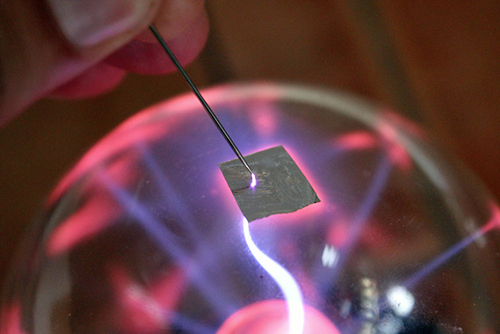
Image courtesy of Jorge Yáñez González
Ask the students to think about these questions:
- Why does the LED light up when it is close to the globe?
- Why doesn’t the LED glow when it is far from the globe?
- Why do you need to hold the LED by just one electrode for it to shine?
When the LED is a long way from the globe, the electromagnetic field produced by the plasma globe is not strong enough to affect the bulb. When the LED is close to the globe, the field causes a small voltage difference across the LED’s electrodes. This will make a current flow in the LED if there is a closed (complete) circuit, which happens if the LED is held by only one electrode. This is because the holder’s own body acts as both a conductor and a connection to Earth, so it closes the circuit – and the LED shines. When both electrodes are held, there is no potential difference across the LED and it does not light up.
2) Using a compact fluorescent bulb
We can explore the same ideas further using a compact fluorescent bulb, holding it from its base. As with the LED, its brightness changes depending on how near or far it is from the plasma globe. In this case students can also see for themselves the effect of quantised energy levels in atoms.
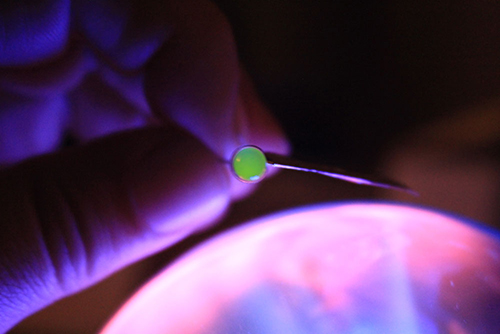
Image courtesy of Jorge Yáñez González
Ask the students to experiment by holding the bulb at different distances from the plasma globe (as with the LED), and to think about these questions:
- Is there a maximum distance from the globe at which the bulb lights up?
- What might be happening inside the bulb to make it glow?
If the bulb is close enough to the globe, the electrons of the mercury vapour atoms inside the bulb will be excited by the globe’s electromagnetic field, which makes the atoms jump up to a higher energy level, emitting UV radiation when they fall back to their normal level. Because this excitation requires a specific minimum amount of energy to happen, the bulb needs to be within a specific distance of the globe. The UV radiation is invisible to the human eye, but it is absorbed by the bulb’s fluorescent coating and re-emitted at a lower energy, which we see as the bulb’s glowing white light.
3) Further explorations with light bulbs
It’s interesting to try this experiment with an old, non-functional fluorescent bulb (if available), as the bulb’s ability to light up will probably be revived in the plasma globe’s electromagnetic field. Most fluorescent bulbs fail because the start-up mechanism for the lighting process stops working, although the physical processes inside the bulb are unaltered – so in some conditions the bulb can still produce its glow.
You can also try repeating the experiment with an incandescent (tungsten filament) bulb. Fluorescent bulbs and LEDs are now in common use because of their low energy usage – which is also why they can light up just by being in the electromagnetic field around a plasma globe. Incandescent light bulbs, however, use much more energy and so will not light up under these conditions.
Using a straight, low-voltage fluorescent tube to explore the electromagnetic field can also be revealing, because its long shape allows students to hold it in different orientations and at different points along its length.
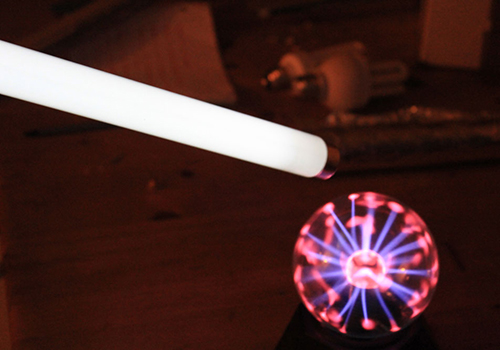
Image courtesy of Jorge Yáñez González
Ask the students to move the fluorescent tube towards the globe so that it glows brightly. If they now grasp the tube at its midpoint with one hand, they will see that it stops glowing from the contact point to the furthest end.
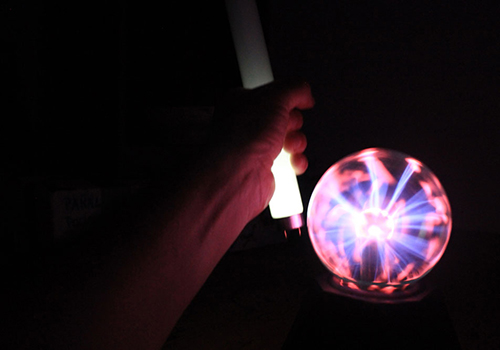
Image courtesy of Jorge Yáñez González
Here, the contact of the hand with the tube allows the electrical energy to discharge towards Earth at the point of contact, preventing the illumination from extending all the way along the tube.
Making sparks fly
In this experiment, we show how to make some safe sparks using the plasma globe.
Suggested time: 15–20 mins (including discussion).
Materials
- Plasma globe
- Aluminium kitchen foil
- Sewing needle
- LED
Procedure
When the plasma globe has been switched on for a couple of minutes, place a small piece of kitchen foil (1 cm x 1 cm) on the top of the globe. Then, very slowly bring the needle towards the foil. When it is about half a centimeter from the foil, you should see an electric arc (spark) jump from the foil to the needle.
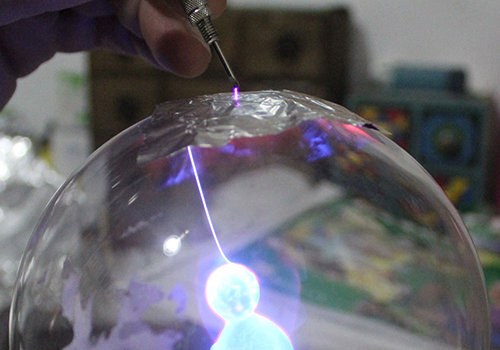
Image courtesy of Jorge Yáñez González
The spark is created because the kitchen foil is a good electrical conductor, and the globe’s alternating field progressively builds up electrical charge on the foil. When we approach with the needle, which is also an electric conductor but has no charge, a vast number of electrons jump from the kitchen foil to the small needle to neutralise this difference in electrical potential between the two materials.
When we place the kitchen foil on the plasma globe, a capacitor is created. The two conductive sides would be the plasma on one side and the kitchen foil on the other. The glass of the plasma globe acts as a dielectric. When we bring a metallic object (the needle) into close proximity, a quick discharge is produced and a small spark can be seen.
We can also go back to our experiment with the LED and see the effects of placing the conducting foil on the globe. With the foil on the globe, hold the LED by one of its electrodes and slowly bring it towards the foil. You should notice that, even when fairly close, the LED does not light up – unlike in the first experiment. However, at a distance of about 0.5 cm, you should see a spark jump from the foil to the LED electrode, and the bulb will glow while the spark extends towards the electrode.
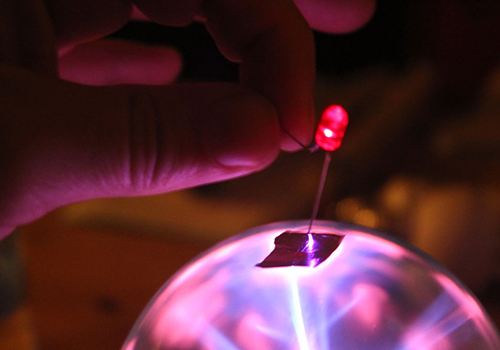
Image courtesy of Jorge Yáñez González
In this case, the LED is only lit by the spark and not by the globe’s electromagnetic field. This is because the intensity of the electromagnetic field is directly related to the size of the plasma globe. In big plasma globes, the electromagnetic field is able to make an LED shine from a certain distance, but with the small plasma globes generally used in education, the electromagnetic field produced is less intense; for the LED to shine from a certain distance, we need to connect it to a capacitor (the kitchen foil that we fold on one of the LED’s electrodes).
Extension activities
The activities described above can be used as a basis for further research on a variety of topics. Students can find out more about:
- Tesla coils and their inventor, Nikola Tesla.
- Plasma as the fourth state of matter. It is said that plasma is the most common form of matter in the Universe; why is this?
- The energy performance of different light bulbs and which bulbs are best for the environment. What should we do with them when they no longer work, bearing in mind that fluorescent bulbs and tubes contain mercury?
Web References
- w1 – A broad and informative article about plasma, plasma balls and their electromagnetic fields, is available on the CPEP physics website.
Resources
- To watch demonstrations of all the plasma globe experiments in this article, see: https://youtu.be/RpCSHbfMDkA
- Visit the University of Oxford’s Department of Physics website for more information about the physics of how plasma globes work.
- Read this very accessible account of how plasma globes work, suitable for younger students.
- For an article on how scientists accidentally created plasma in their microwave, and how they used it for their research, see:
- Stanley H (2009) Plasma balls: creating the 4th state of matter with microwaves. Science in School 12: 24-29.
- Further reading on plasma as the fuel in fusion is available on the EUROfusion website:
Review
Plasma balls are often used to provide a “wow” factor that will enthuse students. This article suggests ways in which a plasma ball can be used in lessons and provides some detail about the underlying physics.
Stuart Farmer, Robert Gordon’s College, UK





